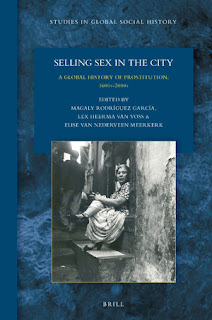Violence against women in cities
With economic growth, more and more department stores, entertainment and coffee houses appeared in Late-Victorian London. The changes led to a higher number of upper and middle-class women on the streets: shopping, strolling or visiting a coffee house. Although their visibility increased, the urban spaces they visited were considered dangerous environments for women. Police protection was limited due to a shortage of officers. To avoid harassment by "male pests", guides were published for women with suggestions on how to behave and dress in public. This phenomenon was not limited to London or the UK. Esmeralda Tijhoff wrote an interesting article on the topic about the Netherlands in which she refers to the popular Dutch etiquette booklet by Van der Mandele from 1896. (2) In it women are advised on how to distinguish themselves on streets from 'public women' (meaning prostitutes) and thus avoid receiving 'dishonourable proposals'.
Julia refers to the closing of brothels as a consequence of this moral panic over safety. Stories in the media from Alfred Dyer and William Stead on the abduction of young women who were then forced to work in brothels and the Jack the Ripper murders on prostitutes increased the moral panic. (3) It led to a legal ban on brothels. Unfortunately, this did not result in a decrease in violence towards women. Julia explains that the ban forced women working in the sex industry from a relatively safe environment of a brothel, towards riskier illegal forms of prostitution. And with it, a dependency for their personal safety arose on third parties, like pimps. The prostitution market did not disappear, it simply organized itself different with the most vulnerable women in society victimized.
Notes
(1) For instance: J. Laite, Common Prostitutes, and ordinary citizens. Commercial sex in London, 1885-1960 (London 2012); -, 'A Global History of Prostitution: London' in: M. Rodriguez Garcia, L. Heerma van Voss & E. van Nederveen-Meerkerk, Selling sex in the city. A global history of prostitution, 1600s-2000s (Leiden 2017) 111 - 137; -, 'Traffickers and pimps in the era of white slavery', Past & Present 237 (2017) 237-269. See also the blogpost I wrote on her latest book.
(2) E. Tijhoff, ‘Thuis in de stad. Hoererende dames en winkelende vrouwen in Amsterdam rond 1900’ Historica 14 (2008) 4. The old publication of Van der Mandele was republished in 2011: E.C. van den M, Het wetboek van Mevrouw Etiquette (Zaltbommel 2011).
(3) Literature on moral panic: UK: J.Walkowitz, City of dreadful delight (London 1992); Netherlands: P. de Vries, Kuisheid voor mannen, vrijheid voor vrouwen (Hilversum 1997); Belgium: J.M. Chaumont, 'The white slave trade affair (1880‑1881): a scandal specific to Brussels?' Brussels Studies 46 (2011) p.1-11.
Source image on this blog post:
Alfred Roloff, Public domain, via Wikimedia Commons




Comments
Post a Comment